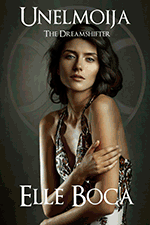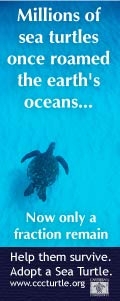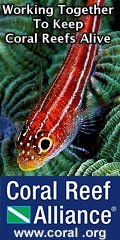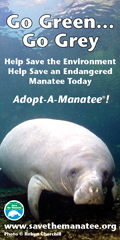by Editor | Jul 30, 2012 | Accomodations, Attractions, Food and Wine
Article and photos by Elena del Valle

Katherine in class
In late April, I traveled to Burgundy, France for a six-night introductory cooking and culinary small group program with some behind-the-scenes features. Included in the English language program were comfortable and modern accommodations with daily room cleaning, meals, cooking demonstrations, transportation and activities with English speaking guides (a service tip was suggested though not required). As part of the program six of us shared Frelon’s Fabulous France, a five bedroom two-story recently renovated house with a working fireplace, complimentary WiFi connectivity, a private swimming pool and two enclosed courtyards (because of the cold that week the pool remained covered and the courtyards empty of guests).
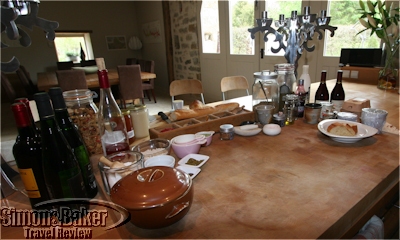
Prime space at the kitchen counter
The house, formerly used as horse stables, had been lovingly renovated by the owners, Katherine and Yannick Frelon, over an intensive 18 month period. The culinary program was led by Katherine, an English cook, and a group of her associates from the same country. It consisted of her cooking demonstrations with some hands on cooking opportunities for those so inclined, daily culinary or wine related excursions, and three non home cooked meals (one a la carte cafe lunch and two set menu gourmet restaurant meals, one lunch and one dinner).
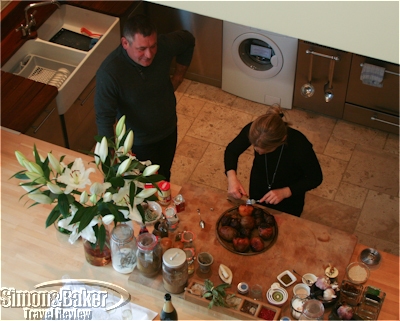
Katherine and Yannick in the kitchen
The house itself, especially the kitchen, was well appointed, spacious and comfortable. Located in Marigny Le Cahouet, a pretty and quiet country village fronting a brook and the famed Burgundy Canal, it provided a placid setting in spite of a rain filled week. The upside of the weather were the uncrowded Dijon market and tourist attractions we visited.
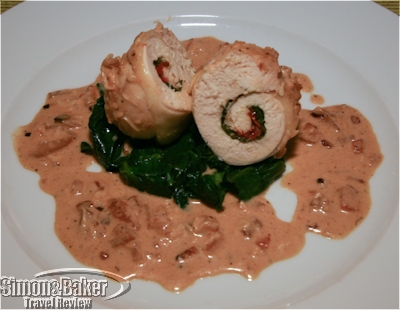
One of Katherine’s many dishes
Katherine, a part-time river barge and freelance cook who had lived in France for many years, dedicated time on four days to cooking demonstrations which resulted in lunch buffets and plated dinners for our group. The meals were prepared from regional fresh ingredients (some from her garden) by her, while we watched and sometimes participated, from her own recipes which she provided in a 72-page printed spiral bound handout on our arrival. Her cooking style, she explained when I asked at the conclusion of the week, is “seasonal, local, fresh and inspired” with recipes designed to translate to cooking students homes on their return to their country of residence.
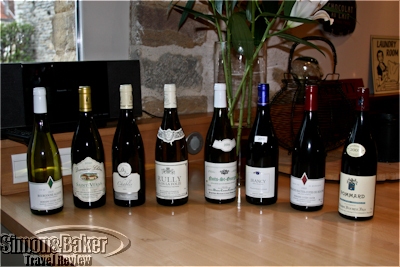
Our first activity was a wine tasting
At the beginning of the week, we were provided with a final itinerary without times or activity duration. Katherine would inform us of times and durations just before the activities on a daily basis or by leaving a printed card atop the kitchen counter. We ate most meals in the house dining room on the ground floor. Breakfast and lunch were self service buffet style and dinner was prepared and plated in the kitchen and served by Katherine or an assistant at the dinner table. Meal times varied depending on the day’s activities. A continental breakfast (hot beverages, self squeezed orange juice, bread, deli meats, cheeses, fresh fruit, yogurt, cold cereal, honey and jams) was usually available an hour or less before departure; lunch was usually served between 1 p.m. and 2:30 p.m. Dinner, usually after 8 p.m., lasted two or more hours.

Katherine demonstrated a cooking technique in class
Our days, spent mostly in each other’s company and with Katherine or a guide, were busier than I had anticipated. From breakfast through the end of dinner the majority of our waking hours were taken up by cooking demonstrations, scheduled activities or meals. That week I was reminded that spending time in close quarters with strangers with varied cultural and social backgrounds may be challenging. At times some of the attitudes and behaviors of other guests, particularly those who seemed to monopolize the conversation, complain and make unsolicited and unwelcome critical remarks, were grating and more than once spoiled the moment.
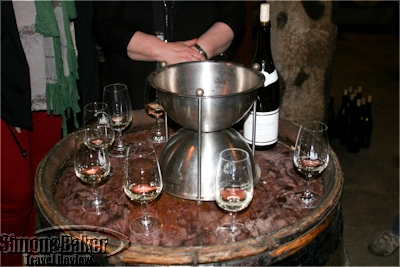
There were several wine tasting opportunities
During the week, there were two wine activities with different guides and visits with tastings to three small family owned wine makers. My favorite experiences by far were the introduction to Burgundy wines by Nancy, a knowledgeable Englishwoman with a ready smile, the first afternoon; and the behind the scenes visit and wine tasting at a Flavigny winery also in her company.
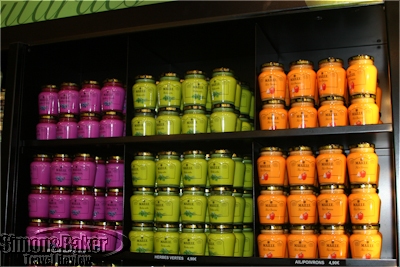
A stop at the Maille mustard shop in Dijon was included
There was a kitchen side cooking demonstration with guest participation at a gourmet restaurant, a visit to Dijon focusing on a market experience and cafe break, a mustard shop stop, a croissant making demonstration by the village baker in the house, and a chocolate shop visit with complimentary hot cocoa and a couple of bite size samples.

Ingredients for a recipe
On our last full day we went to two wine tastings. We also stopped in Beaune for a light lunch at a central cafe, an optional 30-minute visit with our wine guide to the Hospice de Beaune, a historic building and popular tourist attraction, and an hour at leisure for shopping enthusiasts (most of the shops were closed for 30 minutes of that time).
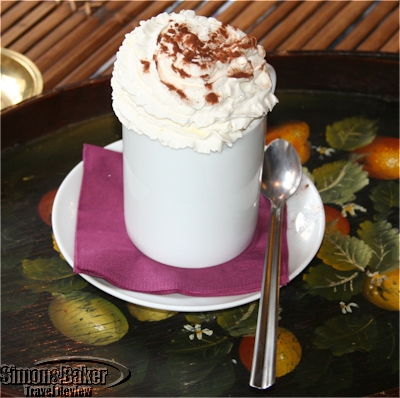
Hot cocoa at the Comptoir des Colonies near the Dijon market
The day after our arrival we drove to a gourmet restaurant in a pretty vineyard setting for a cooking demonstration with the chef followed by a kitchen-side lunch (not a favorite). Unfortunately the chef was in Singapore so the demonstration was conducted in English by one of his staff cooks, a personable Asian woman. Some of the ingredients were unavailable, she informed us at the beginning of the class and had to be substituted in the recipe. Although she tried several times she was unable to demonstrate the foam technique that was central to the recipe; instead of foam the device, when pressed, delivered liquid.
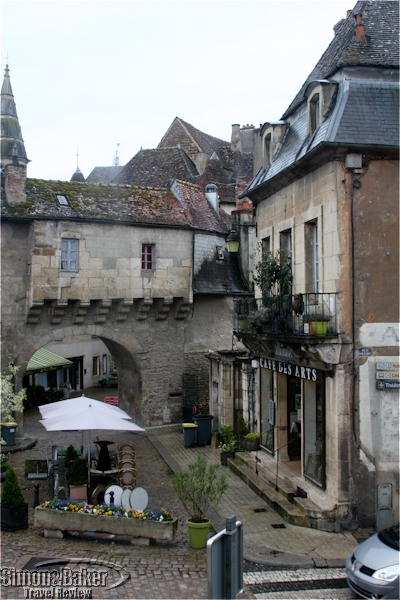
A visit of a cobble stoned street town
Our much anticipated final gourmet meal was at a highly rated restaurant about 30 minutes from the house. On our arrival we were greeted, in charming French accented English, by the owner. Although the restaurant dining room where we were seated faced a lovely garden, our corner table was near the rear of the room rather than the window and my seat faced the wall. A flute of champagne unexpectedly flavored with pear and laurel and a warm cheese pastry amouse bouche distracted me from my initial disappointment of the view. The highlight of the set dinner menu with two house wines was a raw shrimp appetizer and a well cooked river fish. The pigeon was well prepared and presented. I especially liked the tiny but savory thighbone.
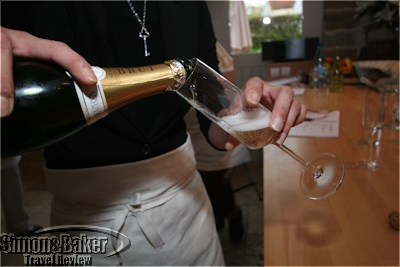
Bubbly was on offer in the afternoons
Following dessert the restaurant manager graciously invited us to the kitchen to meet the chef. While we enjoyed hot beverages in a lounge at the dining room entrance we were presented with a copy each of our menu with photos taken during our brief kitchen visit on the front cover as a memento of the night’s dinner, the closing activity for the week. By midnight we were back at the house and I was busy preparing for my early morning departure to catch the only daily train to the Charles de Gaulle Airport at the nearby Montbard station, a 20-minute drive from the house.
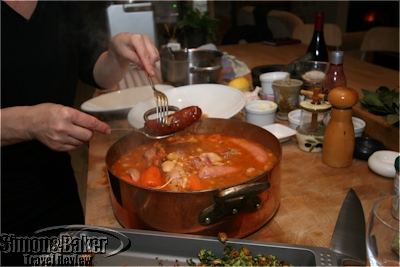
Cassoulet, one of my favorite dishes that week
I would recommend La Ferme de la Lochere (6 Rue de la Lochere, 21150 Marigny Le Cahouet, France, +33 672 86 5609, http://lafermedelalochere.com, katherine.frelon@lafermedelalochere.com) Burgundy culinary program to friends and acquaintances seeking an introduction to culinary Burgundy, related cooking demonstrations and behind-the-scenes activities with an English cook and team, in particular to groups wishing to book the program exclusively or to rent the house.
by Editor | Jun 25, 2012 | Attractions, Ecotourism
By Elena del Valle
Photos by Gary Cox
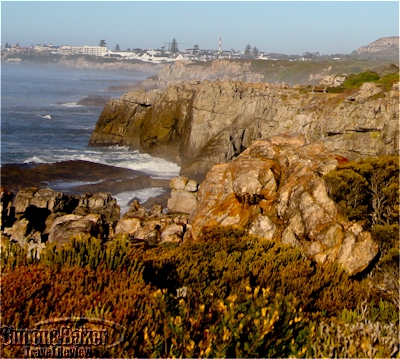
The cliff walk offered dramatic views of the ocean and cliffs
One of my favorite walks in South Africa is in the Western Cape. During our last visit to Hermanus we would walk the Cliff Path Nature Area daily for a couple of hours enjoying the stunning vistas and hoping to spot a whale, any whale even if it was not whale viewing season. Just as the sun was about to rise we would walk from Birkenhead House, a small hotel in Voelklip, west through the residential area of Kwaaiwater into central Hermanus on the marked and guarded (by uniformed security company staff) path which hugged the coast for miles, part of the Fernkloof Nature Reserve. During our walks, we saw a variety of coastal plants and birds, dassies (said to be a tiny relative of the African elephant), teenage seals and unexpectedly two brides whales which, according to the townsfolk, were a rare sighting.

Shy little birds were out at first light
Occasionally small markers would point the way and large IFAW (International Fund for Animal Welfare) signs would provide information about the flora and fauna of the area including, of course, the whales that Hermanus is famous for nationally. In addition to the signage there were rubbish bins and indications that someone in the municipality cleaned and managed the path on a regular basis. We also noticed designated parking areas at various places that intersected the walkway.
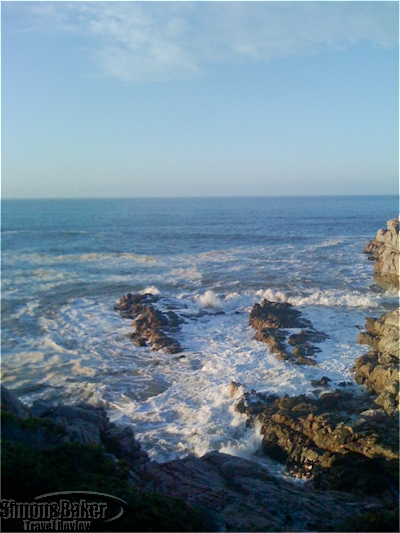
The waves constantly smashed into the rocky islands and shoreline
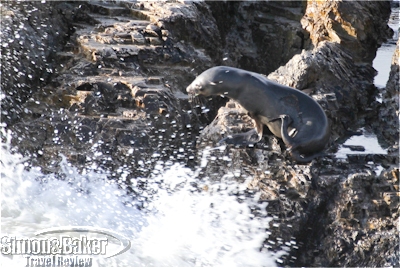
Seals climbed onto the rocky islands
The path passed steps below the rear terrace of our hotel and continued past Hermanus along the coast. We found it ideal to depart just before sunrise. Earlier than that and it was difficult to see the unlit path clearly, risking a twisted ankle or fall, and loosing out on of some of the beauty of the scenery for lack of light. Much later than sunrise was less worthwhile in part because the bird viewing and photography light were best early in the morning. From a comfort perspective as the sun emerged the light quickly became harsh and, although the ocean breeze was pleasant, the summer sun was punishing causing us to tire prematurely.

Small colorful flowers brightened the fall landscape
Along the way, benches were scattered at strategic spots where we could stop to enjoy the sea views. From the cliffs we could observe the crashing waves, copious quantifies of sea kelp, a variety of birds and coastal views of the upscale area. Adjacent to the walk there were beautiful houses in varied styles and sizes and as we neared the town there were some small buildings too.
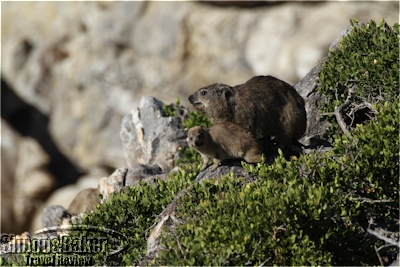
A dassie family perched on the rocks
We often crossed paths with locals out for a walk or jog, sometimes in the company of their unleashed dogs. Most of the paved walkway was built within a natural area surrounded by greenery and flowering plants passing through beaches, up cliffs and across bridges. There was a less attractive segment that veered inland on a sidewalk for a few minutes along the well trafficked main road before returning to the waterside and reaching central Hermanus. On Marine Drive, in the central part of town and across the street from the bay, we discovered Yves’s Pudding & Pie (87 Marine Drive, +27 082 924 0920), an informal spot to stop for a quick savory bite and cold beverage. We especially liked the pies.
by Editor | Jun 4, 2012 | Attractions
Article, video by Elena del Valle
Photos, video editing by Gary Cox
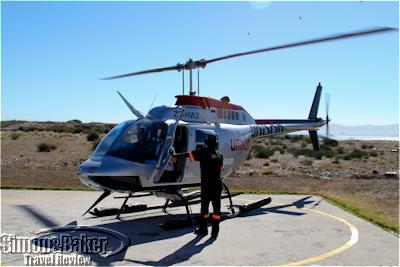
A pretty day for flying
Although each time we visit the fair city of Cape Town, South Africa it is a little more touristy than the last time we always leave enchanted. The setting between the ocean and the mountains is mesmerizing. Nowhere is that more evident than from above.
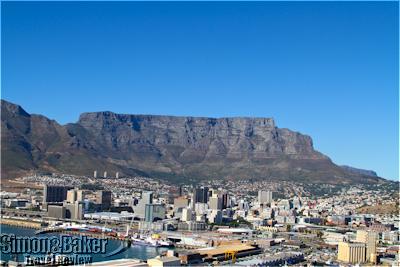
Cape Town and the famous Table Mountain
On our recent visit to Cape Town we went on an Atlantico Tour, a brief 18-minute (our camera time stamps reflected a 14-minute helicopter flight) scenic helicopter tour aboard a 1990 Bell JetRanger for up to four passengers (although we were the only ones aboard that day), with Nac Makana Aviation departing from a helipad very near the famed V & A Waterfront. It was a sunny, breezy and warm morning when we arrived. A friendly young lady at the front desk welcomed us when we walked in. Already there were a dozen or so tourists on the deck facing the departure area. Within minutes the staff had greeted us, weighed us and our hand held items and shared information about the flight. Next, someone provided a life jacket and led us to the helicopter, making sure we were strapped in and had our headsets on so we could communicate during the flight.
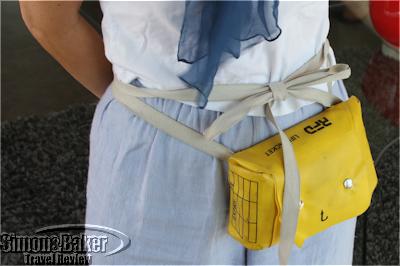
A life jacket for safety
Moments later we were airborne, flying over the waterfront and rising quickly above the cityscape. We flew toward Constantia Nek and returned via the Southern Suburbs; this routing, we learned later, was offered weather permitting to allow visitors to see more of Cape Town. Guy Douglas, our pilot with 800 hours of flying experience, made sure we were comfortable and left us to enjoy the view, pointing out the sights occasionally. No sooner did I recognize what an area was and focused my camera on it that the next beautiful sight appeared. Our flight took us over the V & A Waterfront, the outskirts of the city, past Table Mountain, Lion’s Head, the new Green Point Stadium, Sea Point, the beaches of Clifton and Camps Bay via the Twelve Apostles mountain range to view Hout Bay, Constantia Nek over the Constantia Wine Lands and back via the residential areas of the Southern Suburbs.
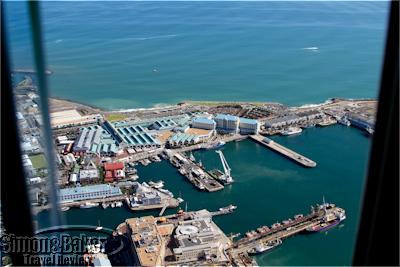
The V&A Waterfront from above
On our return we were whisked back to reception where a staff member offered us a glass of South African bubbly or water and a complimentary copy of Cape Town The Fairest Cape, a 22-minute tourist promotional DVD produced in 2010 by Bright and Gentle Television Productions and directed by Gary Wilson, general manager, NAC Makana Aviation. Atlantico Tour, NAC Makana Aviation, East Pier Road, V&A Waterfront, 8001, Cape Town, South Africa, +27 021 425 3868, www.nacmakana.com, info@nacmakana.com
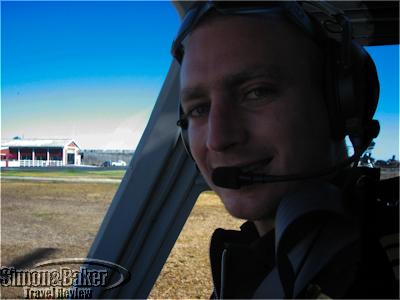
Our pilot Guy Douglas
by Editor | May 21, 2012 | Accomodations, Attractions, New Articles
Article and photos by Josette King

The M/Y Grace at anchor in a secluded cove of the Galapagos archipelago
After a 1,000-kilometer flight over empty Pacific Ocean waters, the AeroGal Airlines jet was preparing to land on San Cristobal, the easternmost island of the Galapagos Archipelago. The few returning locals were already gathering their belongings. Meanwhile, we the tourists were craning our necks to catch a first glimpse of the islands. The plane banked, revealing under its wing a zigzag of rocky coastline, punctuated by an occasional crescent of white sand; and no discernible sign of human life. Another turn unveiled a dazzling panorama of ancient volcanic peaks and dark rock formations emerging from an impossibly blue sea. All this natural splendor, and we hadn’t yet landed.
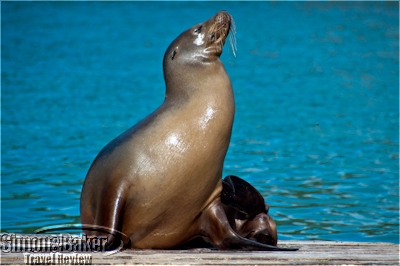
Galapagos sea lion
Once we did, I discovered another unique characteristic of the islands: the sense of undeniable entitlement of its wildlife. Even in the center of Puerto Baquerizo Moreno, the tiny provincial capital of the Galapagos adjacent to the airport, birds and reptiles and especially sea lions treated our presence with superb indifference. The later, enjoying their siesta sprawled on the boat dock, didn’t even twitch as I squeezed by to board the panga (local inflatable zodiac-type skiff) that was to take me to the Motor Yacht Grace.
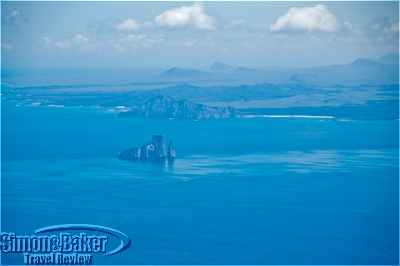
San Cristobal landing
My first glance at the elegant lines of this classic yacht was a special thrill. It brought back fantasies I had shared with an entire generation of French schoolgirls half a century before. Its owner was Prince Rainer III then, and it was named the Deo Juvante (Latin for with God’s help) after the motto of the house of Grimaldi, the rulers of the tiny French Riviera principality of Monaco for almost a millennium. For a few weeks in 1956, it had been front page news on French magazines and movies screens: the prince, sailing to meet the ocean liner USS Constitution to welcome his fiancee, the American movie star Grace Kelly; then the following week, Prince Rainer and the now Princess Grace boarding the yacht again for a seven-week honeymoon. Throughout the spring, there had been images of the yacht anchored in the most romantic destinations around the Mediterranean. Now this glamorous vessel was to be my home for a seven-night cruise around the Galapagos Archipelago, royal matrimony not required.

The shaded fresco dining area at the rear of the main deck
The yacht, renamed the M/Y Grace in homage to its most illustrious owner, is now the property of Quasar Galapagos Expeditions. Its owner Eduardo Diez, a man with a passion for classic yachts, oversaw a two-year, $2.5 million overhaul of the ship, while preserving its distinctive lines. The Grace, newly outfitted with a state-of-the-art stabilizer system to ensure smooth sailing on the open waters around the Galapagos islands, a large hot tub on the sundeck, modern bathrooms in each of its nine staterooms and air conditioning throughout, began operations in the spring of 2009. While I admit that it was the prospect of sailing on the Grace that propelled my desire to visit the Galapagos “some day” to the top of my travel wish list, the understated luxury of the vessel turned out to be merely the setting for a unique wilderness adventure. With only seven passengers and a crew of 10 on board, our naturalist guide, Rafael Pesantes Aguirre (Rafa for short) quipped that our odds for mutiny were unpromising.
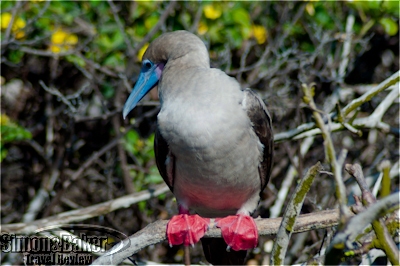
Red footed booby
But between the attentive pampering of the friendly staff and the exhilarating daily discoveries of the cruise, mutiny was the last thing on my mind. The exceptional itinerary took us to remote places rarely visited by larger ships. And Rafa, a third generation native of the islands and an ornithology graduate from San Francisco University in Quito, coupled an encyclopedic knowledge of the natural wonders of the area with the familiarity of one who has swum since childhood in the crystal clear waters of its most secluded coves. Our land excursions were filled with close encounters with some of rarest wildlife on the planet. We wandered on powdery white beaches shared only with colonies of sea lions and hiked along black lava rock paths to observe at close range the courtship ritual of Nazca boobies and waved albatross.

Fernandina marine iguana
We rode our panga along the edge of vertical cliffs dotted with blue-footed boobies and tiny Galapagos penguins, and watched frigate birds and brown pelicans nosedive for their breakfast. For me the highpoint of the day was invariably our snorkeling expedition. In island after island, Rafa led us to the most exotic marine life I have ever observed. I swan surrounded by so many giant sea turtles that it was a challenge to get out of their way. I observed a hammerhead shark, mercifully unconcerned by my presence; and I can now boast that I was personally pecked by a flightless cormorant! Visit the Simon & Baker Travel Review to read more about my Galapagos Archipelago cruise aboard the M/Y Grace.
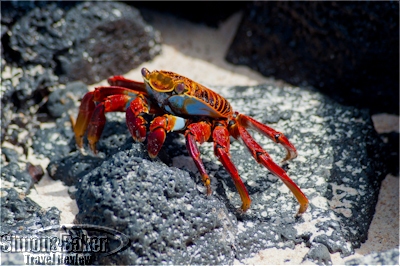
Sally Lightfoot crab
by Editor | May 7, 2012 | Attractions, Luxury Travel
By Elena del Valle
Photos by Gary Cox

The Saba Tourist Bureau
I loved Saba, a small Dutch Caribbean island, for its unspoiled and picturesque character. What this volcanic Leeward Island lacked in size it made up for in beauty, natural features and sheer determination. For example, the islanders were told by experts in Holland early last century that it was not possible to build a road due to the steep incline of the mountains. Refusing to accept that ruling one man took a correspondence course and with the help of his fellow islanders built the beginning of what today is called simply The Road.
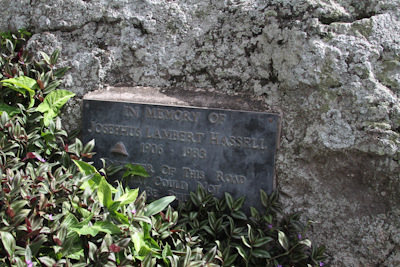
A plaque to Josephus Lambert Hassell, engineer of the road
With a population of less than 1,500 and diminutive (it occupies five square miles), the tourist attractions were mainly scenic, we expected before visiting the island. Cars were scarce in Saba. We had a few hours to see what we could while our ship, the SeaDream I, stopped there and we intended to make the most of it. With a little help from the crew we were able to find a taxi, the only one available that day apparently. The driver, a friendly Irishman who had relocated to Saba only a few months earlier with his van (the windows in the rear of the van did not open we later discovered with disappointment), explained that he would be pleased to show us around the island if we were willing to share space and wait for him.
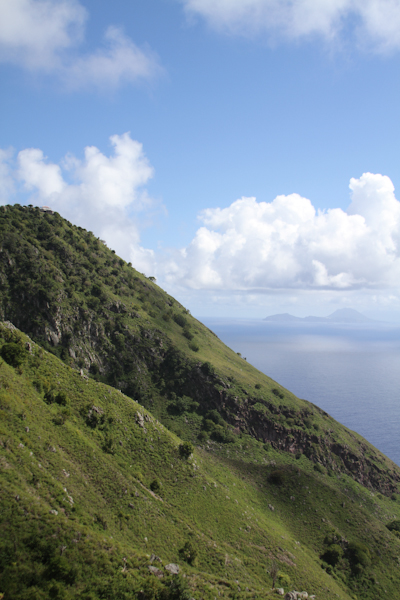
Saba in the foreground and remote islands on the horizon
Six of us shared the van up the narrow and steep roads. He dropped two of our group at the entrance to a hiking trail (they reported having a wonderful time later when we met up aboard the ship) before leaving us in The Bottom, the island’s main urban area. He would take care of local customers (many of the medical school students were going on vacation and there was a wedding the next day) who had booked his services already and return for us about 90 minutes later.

We stopped at this church with a view
When he returned he had a glass of fresh made fruit juice with us before the four of us climbed into his van to see the sights. Minutes later we felt transported back in time when we stopped at a small church with a million dollar view. Although the church was closed there was a kind lady running a simple small cash only shop behind the church. She sold handmade lace in the tradition and style of Saba, a dying art, our driver shared as we departed having bought one of the treasured lace pieces.
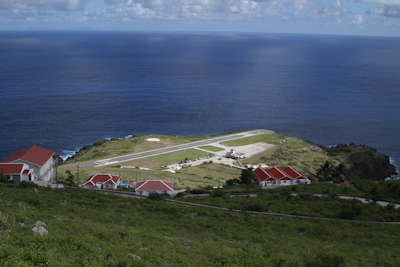
The tiny Saba airport
From there we drove downhill toward the waterfront island airport. On our way back our driver showed us the house he rented as we drove by it on way back toward The Bottom and the dock where we had arrived.
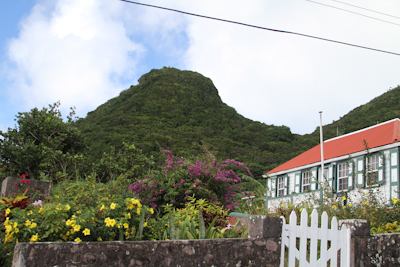
Cute little houses and flowers dotted the hills
Earlier while we waited for our guide and driver to return we had made our way around the hilly village, picking up tips and information at the tourist office where a friendly staff person welcomed us, passing a cafe and small indoor market and walking up a steep hill toward JoBean Glass unsure if it was open for business. Our efforts were rewarded when we arrived at the un-airconditioned shop and found it open. A shy young lady inside said we were welcome to browse around at our leisure. Every surface, every corner of the shop was filled with glass items, many made from Venetian glass, we later found out from the friendly owner who popped by for a few minutes.
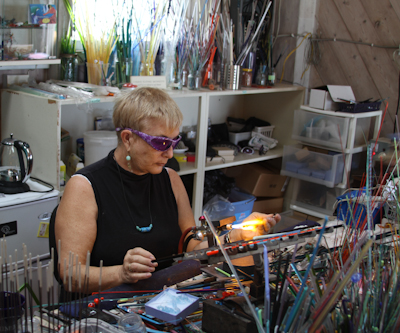
JoBean Chambers demonstrating a technique to fashion colorful glass jewelry
JoBean Chambers, a lively and vivacious American woman who had lived and worked on the island for many years, showed us the glass pieces she was making for the wedding we had heard about, and gave us a brief glass making demonstration. Watching her flame work the thin and colorful glass tubes it seemed easy to create pretty seahorses, turtles, frogs, fish, mermaids, dive flags, starfish and other attractive shapes. She would heat and swirl the glass quickly and easily (for her), then attach another piece of glass in a different color to the incipient shape, adjusting the width and style along the way. In moments we could distinguish a multicolored frog and after that a mermaid. It was hard to imagine the glass melts at temperatures of more than 2,000 degrees Fahrenheit.
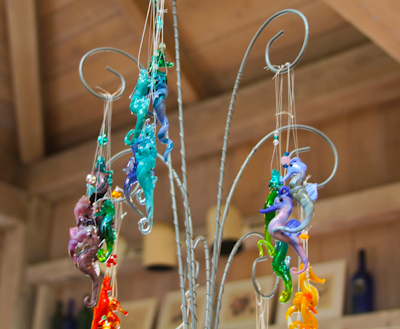
Many of her glass creations were sea creatures
A fan of hot glass since 1989 she had learned her skills, in part at El Vetro in Venice, Italy where she studied, according to her website, with Lucio Bubacco and Vittorio Constantini. Her work was exhibited in art galleries in the United States and the Caribbean, including the Corning Museum Shop. She offered glass workshops in her hillside studio for up to five students at a time. Next time we visit Saba maybe we will take one of her workshops.
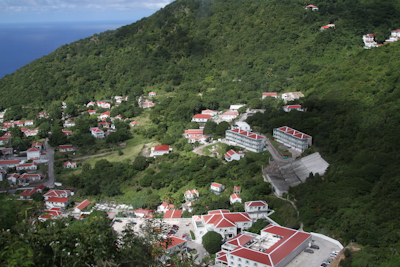
Our visit to Saba was a special treat and one of my fondest memories from our week long Caribbean cruise. This was in part because of the pretty hillside houses in the small towns, the old style lace sold behind the church, our shared taxi tour and fun stop at JoBean Glass Art Studio (Booby Hill, Windwardside Saba, Dutch West Indies,+ 599 416 2490,www.jobeanglassart.com, jobean@jobeanglassart.com).
by Editor | Apr 23, 2012 | Accomodations, Attractions, Ecotourism, New Articles
Article and photos by Josette King
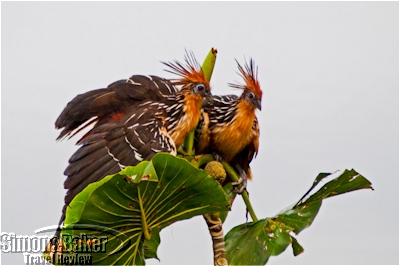
Hoatzin birds were a frequent sight near the lodge
“Stop, stop!” I sputter, too excited to keep my voice down. Fabian, the local park ranger who is paddling, doesn’t speak English but he gets the idea and brings the canoe to a smooth halt. Roberto, my Ecuadorian guide who speaks English fluently, looks at me askance. He has just pointed out a large bird perched in the dense jumble of rainforest. It looks like a chicken with too much turquoise eye shadow and a bad hair day. “The bird,” I exclaim. “Yes, it’s a hoatzin,” he reiterates matter-of-factly. He clearly fails to grasp the importance of the moment. So does the bird, which has by now been joined by two of its friends. They are engaged in a croaky argument while heartily tucking into the foliage. I feel compelled to explain that on a previous Amazon visit, a thousand miles downriver from here, I had once spent a whole week, including a half-day hike in the waterlogged underbrush, in search of a hoatzin. And I had only managed to hear its distinctive cry and ponderous take off as it vanished into the forest canopy. “We have lots of hoatzins here,” Roberto assures me after I have photographed these to my heart’s content, and for good measure a rare rufescent-tiger heron that has been observing the proceedings from a nearby stump.

The king size bed was draped in mosquito netting
We resume our slow way upstream under an arch of tangled mangroves and palms, along the narrow channel that connects the Napo River, one of the most important tributaries of the Amazon, to Anangucocha Lake. We are in the heart of 21,400 hectares (82 square miles) of conservation land located on the ancestral territory of the Kichwa Anangu community, in the northwest corner of Ecuador’s Yasuni National Park. The park is a UNESCO Biosphere Reserve regarded by scientists as one of the most bio-diverse areas on the planet. Several notable sightings later, including a tree-toed sloth and my first ever monk saki monkey, we reach the lake. On its far side, the shore is dotted with the thatched-roofed, bright ocher adobe bungalows of the Napo Wildlife Center luxury eco-lodge.
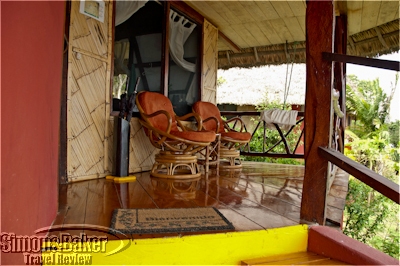
My bungalow had a shaded terrace overlooking the lake
Set into some of the most pristine rainforest environment I have ever visited, the lodge is designed to meet the high expectations of international tourists for wilderness accommodations. It features attractive bungalows with private terraces overlooking the lake, modern bathrooms, round the clock electricity and WiFi connection throughout the property. Strategically located observation towers at the lodge and in the forest offer a unique perspective of the abundant wildlife around the lake and above the forest canopy. My wildlife viewing is exceptional, not only for its abundance and variety but because of the excellence of the guiding. At the lodge, guides come in pairs: a bilingual, state-licensed guide and a native Yasuni Park-licensed ranger who also acts as a local guide, sharing his knowledge of plants, medicinal plants and Kichwa traditions. One evening, they take me on a nighttime canoe ride in the swamps near the lodge, with a special spotlight to view nocturnal creatures.
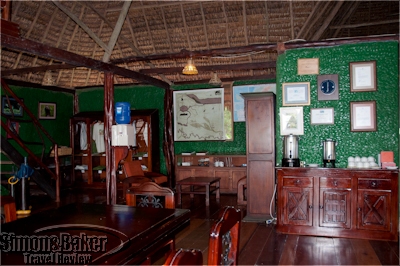
Coffee was served around the clock in the main hall
Beyond the excellence of accommodations and wildlife viewing opportunities, a highpoint of my visit is the opportunity to observe first hand the positive impact of the Napo Wildlife Center on the daily life of the Anangu people. The lodge and conservation land are wholly owned and managed by the Kichwa Anangu community. They are the keystones of a far-reaching program to improve the quality of life of the people and preserve the integrity of their ancestral territory and culture while providing them with sustainable employment. Most of the staff comes from the community. Their pride in the Napo Wildlife Center is palpable, and translates into warm and attentive service. Additionally, while the life of the community is separated from tourism activities, one hour downstream from the lodge, I see women welcome guests to the Interpretation Center facility adjacent to their village. It is especially rewarding to be able to connect with them (with Roberto as interpreter) as they introduce me to the tasks of their daily lives as well as their traditional Kichwa crafts and dances.
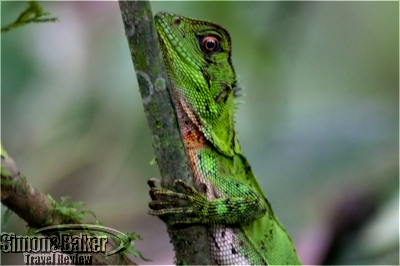
An Amazon forest dragon
I am gratified to hear of the rigorous sustainable tourism practices implemented by the Napo Wildlife Center program. Profits are reinvested within the community, with education and healthcare as major priorities. The center also returns a share of the annual profits to each family and provides a stipend to the elderly. To limit the lodge’s impact on its environment, it has implemented an environmentally sustainable sewage system, with waste waters treated to high standards before being released into the swamps. Trash is kept to a minimum and composted whenever possible. What is safe to burn is burned and buried, with the remainder transported to designated landfills outside the park. And these practices have been extended to the Anangu community at large, for a cleaner, healthier living environment.
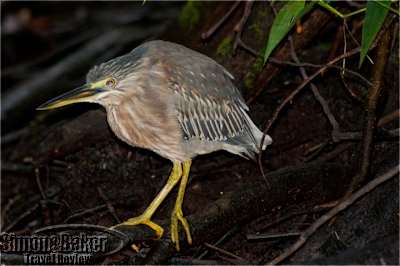
A striated heron
The Napo Wildlife Center is also engaged in a strong anti-poaching program, with its conservation land patrolled by community rangers employed and equipped by the lodge. The Napo Wildlife Center was recognized in 2009 with the Rainforest Alliance Community Sustainable Trend Setter Award, and the Best Jungle Lodge Award from the Latin American Travel Association at the World Travel Market in London, U.K. And it is becoming a model for other sustainable tourism community projects throughout Ecuador.
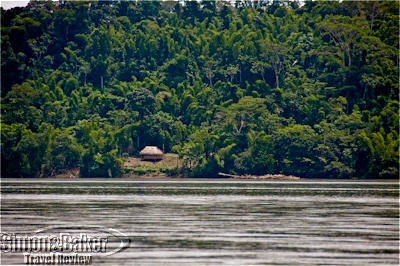
The banks of the Napo River were a tangle of dense rainforest
And by the way, Roberto was right. We came across so many hoatzins during my four-day visit that by the time I left, I barely spared them a glance. Visit the Simon & Baker Travel Review to read more about my stay at the Napo Wildlife Center.

















































